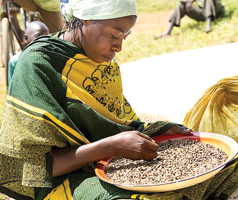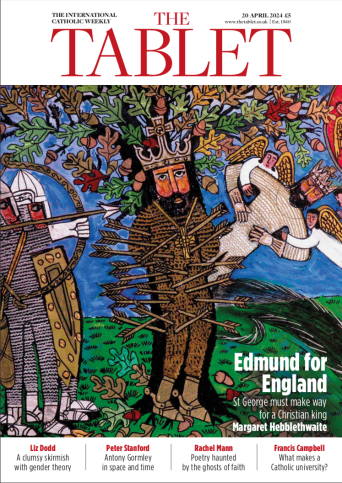Consumers should still trust the Fairtrade label to deliver decent returns to producers in the developing world despite recent research revealing that the poorest agricultural workers receive little benefit, argues one of the champions of the system
RECENTLY AN academic study found no evidence that fair-trade agricultural workers earn higher wages than other rural labourers, and indeed appear to earn less. This result has caused confusion for consumers who had thought they were benefiting the poor of developing countries with their choices of certified chocolate, coffee, flowers and other products.
The four-year study has also caused some tension between fair-trade bodies and the academics conducting the research, which was commissioned by the Department for International Development (DfID) from a team at the School of Oriental and African Studies (Soas), University of London, and used state-of-the-art technology to identify and interview 1,700 workers in Ethiopia and Uganda.
Over the past 20 years, the consistent message, supported by many other independent studies, has been that “fair trade guarantees a better deal for Third World producers”. But this latest study suggests development resources might be better deployed in public health and education, especially that of girls, and in state encouragement of large-scale private agriculture. While the Fairtrade Foundation declares it welcomes constructive criticism, its suggestion that the study is flawed has not gone down well at Soas.
For consumers who have heard of fair trade and have approved of it because it sounded vaguely ethical, a seemingly simple choice has become more complicated. First, they need to be clearer about the distinction between Fairtrade, the product labelling system, and fair trade, the wider movement of which it is part. Then there is the confusion at the heart of the Soas study between small farmers, who own or rent a plot of land, and wage labourers.
The ideal model of fair trade (there are others) is based on the self-employed small farmer who works a small plot with family labour. These farmers band together in cooperative associations through which they can process their produce for export. The associations apply for Fairtrade certification and obtain the premium prices from Western importers. The Fairtrade label audits the long supply chain between the consumer and the farmer and aims to ensure compliance with the Fairtrade standards.
Previous academic studies have mainly confirmed that the benefits of fair trade are passed to the farmer, to a greater or lesser degree. The Soas study goes one step further and asks: what about the seasonal, casual labourers who work for the small farmers or their cooperatives? The researchers argue that these wage labourers have been ignored, mainly because they are invisible.
The extraordinarily painstaking study surveyed the population of entire areas, with and without fair-trade farms, going from house to house and even from room to rented room, marking each location using GPS and using hand-held computers to interview individuals in a rigorous manner. Since the cost of this study equals about two years’ income for each worker studied, it is unsurprising that it has only been made possible by substantial British government funding.
SO THIS IS not a matter of a breach of the trust placed in fair trade. It is unclear, even to Soas, why casual labourers should earn less from fair trade; the tacit assumption in the absence of firm evidence has been that they are at least no worse off.
The study has inevitable limitations: for example, it considers only two African countries and three commodities – coffee, tea and flowers. Yet some criticisms of the methodology seem misplaced and unnecessarily defensive. The proportion of a certified producer association’s sales going to fair-trade buyers is, strictly, irrelevant. The Soas study does allow for differences in scale between small and large farms and makes reasoned judgements as to whether the observed differences could be due to other independent factors. And this is not the first time low wages have been reported: the Financial Times found breach of minimum wage laws in Peru as long ago as 2006.
There is therefore no obvious reason to doubt, on the one hand, the broad thrust of the evidence on workers’ wages gathered at such cost or, on the other, that small farmers are better off with fair trade. Fair trade too has its limitations and its leaders need to take – and seem to be taking – this evidence seriously. Yet fair trade is often criticised for the audit burden it imposes; a necessary outcome of tighter standards might be that fewer farmers sign up.
The legitimate grievance of the fair-trade bodies is that the report’s wider policy conclusions run some way ahead of the evidence. Whether fair trade is the answer depends on the question. Fair trade is an exercise in solidarity. It does not rely intrinsically upon either public or private subsidy, and is not at the expense of public health or education programmes, nor indeed of minimum wage and other labour rights legislation. The main comparison must be made with unrestrained capitalism.
The Soas study notes a wide range in the size of the farms operated by the members of fair-trade cooperatives so that members with larger farms, and presumably larger numbers of hired workers, tend to dominate sales, management and the distribution of profits in absolute terms. Describing these larger farms as essentially capitalist enterprises, exploiting the cooperatives in order to capture various subsidies and private benefits, Soas concludes that it would be more effective to drop the facade and simply encourage the consolidation of agriculture in private hands.
Stalin took a similar view during the 1920s. Land reform in 1906 had led to the emergence from the wider Russian peasantry of a class of successful yeoman farmers (the kulaks) who employed poorer peasants and landless labourers. The kulaks were mostly dispossessed after the 1917 revolutions but they became a powerful mythic figure in the hands of Stalin as he sought to collectivise agriculture, purportedly in the interests of the poorer peasants and the landless. In fact, collectivisation was driven by the needs of the urban population and Stalin’s military-led programme of industrialisation. When the peasants preferred to bury their grain and slaughter their animals rather than hand them over to the state, Stalin declared war. Anyone who resisted became a kulak. Millions died.
Soas is not, of course, recommending Stalin’s methods, even if Professor Christopher Cramer, the lead researcher, has publicly quoted Lenin’s negative verdict on cooperatives with approval. However, it is not self-evident that the creation of a landless workforce employed by large, probably foreign-owned, agribusinesses in a form of state capitalism would be an improvement from the perspective of either the smaller farmers or wider society.
FIVE MILLION steel ploughs would have allowed the Soviet peasantry to meet Stalin’s production targets. There is political and developmental value in the existence of a strong, independent cooperative sector and the vast majority of small farmers are poor by any standard. Although fair trade must protect the poorest of the poor, this should not be at the expense of its commitment to enabling small farmers to determine what is best for them. Consolidation and industrialisation may indeed be in their own long-term interests.
What Professor Cramer considers a romantic aim is that, despite the long historical record of the dispossession of peasants by the state or the rich, small farmers are empowered to improve the material fabric of their lives at a pace and in a manner which respects the human dignity, both of themselves and of their hired workers.
Dr Mark Hayes is fellow and director of studies in economics at Robinson College, Cambridge. He was the principal founder and first CEO (1990–99) of Shared Interest, a cooperative that finances fair trade. He is newly appointed the first holder of the St Hilda Chair in Catholic Social Thought at Durham University’s Centre for Catholic Studies.





 Loading ...
Loading ...
What do you think?
You can post as a subscriber user...
User Comments (2)
The problem with Fairtrade and charities purporting to lift people out of dire poverty is that the money they receive from well-meaning donors is immediately swallowed-up in organisation/management of the schemes and seldom (if ever) goes directly to the individuals that desperately need the help. As the governments of these countries are also very corrupt, it is difficult to see how these people can genuinely be helped. As the West is now failing its own people by lack of job creation, poor pay for those who have work, having to support legal and illegal immigrants and crumbling health services, it is difficult to see how the plight of African farmers can be improved. Also, the price label attached to the Fairtrade product has to be comparable to their rivals and this isn't happening at the moment.
Seems to me that supporting Fairtrade must be part of a bundle of activities we do. Consumer power is very much limited - both by lack of information, but also sometimes by information overload.
We should also think outside the box. If it is about lifting people out of the so-called poverty line, how about a straightforward "world dividend" for every single person, set at the poverty line?
I understand some experiments are being done in villages for such schemes with positive results.
Poverty line: $1.25 per day.
World population: 7.1bn
This equates to: $3.2 trillion
Global GDP 2012: $72,700 trillion
Additional tax to fund: 4.5%.
Any takers?